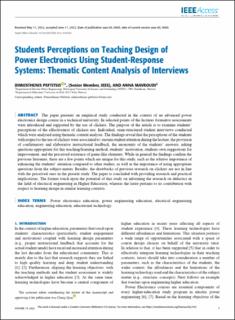| dc.contributor.author | Peftitsis, Dimosthenis | |
| dc.contributor.author | Mavroudi, Anna | |
| dc.date.accessioned | 2022-12-27T12:49:05Z | |
| dc.date.available | 2022-12-27T12:49:05Z | |
| dc.date.created | 2022-06-17T17:23:47Z | |
| dc.date.issued | 2022 | |
| dc.identifier.citation | IEEE Access. 2022, 1-13. | en_US |
| dc.identifier.issn | 2169-3536 | |
| dc.identifier.uri | https://hdl.handle.net/11250/3039540 | |
| dc.description.abstract | The paper presents an empirical study conducted in the context of an advanced power electronics design course in a technical university. In selected points of the lectures formative assessments were introduced and supported by the use of clickers. The purpose of the article is to examine students’ perceptions of the effectiveness of clickers use. Individual, semi-structured student interviews conducted which were analysed using thematic content analysis. The findings reveal that the perceptions of the students with respect to the use of clickers were associated to: sustain student attention during the lecture, the provision of confirmatory and elaborative instructional feedback, the anonymity of the students’ answers, asking questions appropriate for this teaching/learning method, students’ motivation, students own suggestions for improvement, and the perceived existence of game-like elements. While in general the findings confirm the previous literature, there are a few points which are unique for this study, such as the relative importance of enhancing the students’ attention compared to other studies, as well as the importance of using appropriate questions from the subject-matter. Besides, the drawbacks of previous research on clickers are not in line with the perceived ones in the present study. The paper is concluded with providing research and practical implications. The former touch upon the potential of this study on informing the research on didactics in the field of electrical engineering in Higher Education, whereas the latter pertains to its contribution with respect to learning design in similar learning contexts. | en_US |
| dc.language.iso | eng | en_US |
| dc.publisher | IEEE | en_US |
| dc.rights | Navngivelse 4.0 Internasjonal | * |
| dc.rights.uri | http://creativecommons.org/licenses/by/4.0/deed.no | * |
| dc.subject | Ingeniørdidaktikk | en_US |
| dc.subject | Engineering education | en_US |
| dc.title | Students Perceptions on Teaching Design of Power Electronics Using Student-Response Systems: Thematic Content Analysis of Interviews | en_US |
| dc.title.alternative | Students Perceptions on Teaching Design of Power Electronics Using Student-Response Systems: Thematic Content Analysis of Interviews | en_US |
| dc.type | Peer reviewed | en_US |
| dc.type | Journal article | en_US |
| dc.description.version | publishedVersion | en_US |
| dc.subject.nsi | VDP::Elkraft: 542 | en_US |
| dc.subject.nsi | VDP::Electrical power engineering: 542 | en_US |
| dc.source.pagenumber | 1-13 | en_US |
| dc.source.journal | IEEE Access | en_US |
| dc.identifier.doi | 10.1109/ACCESS.2022.3183584 | |
| dc.identifier.cristin | 2033032 | |
| cristin.ispublished | true | |
| cristin.fulltext | postprint | |
| cristin.qualitycode | 1 | |

